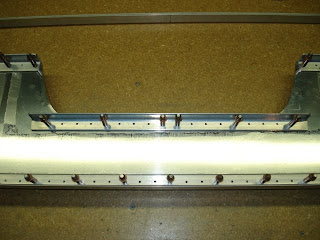Build hours: 697
Progress has been made since the last update in August. We decided to build our ribs for the experience, weight savings and to use up all of the accumulated cutoffs instead of buying 2 additional 4' x 12' sheets. So far, the rights side ribs and spars are completed and the left side rib parts are made.
This is the particle board jig to hold the rib parts in place during assembly. The top and bottom caps were bent in the brake and then shrunk to the rib pattern. An endless number of braces were folded (enough for 2 sets of ribs).
Alignment dowels were inserted into the jig to allow the pattern pieces to be moved to the opposite side of the build board to make left or right ribs.
A form was made to bend the nose pieces over and a particle board flanging die made to make the lightening hole flange. Shrinking of the flanges manually and with the shrinker was required.


Finished rib assemblies.
We used 3/32" solid rivets to assemble the ribs. After you get the rivet driving going, its as fast as pop rivets and gives better edge distances.





These are the 4" or 4 1/2" flanging dies for the spar lightening holes. The flanges stiffen the web considerably even though all of those holes only remove 3.7 ounces from each spar.



A 14' jig was made that would hold the spar center section and one outer spar at the correct angle. The spar fittings were prepared and clamped. The jig was set at the correct height for the drill press. All spar fitting holes were drilled undersized and reamed to .002 or .001 under as required.


Additional rounding and cleanup on the spar fittings was completed. All spars are done.



















































